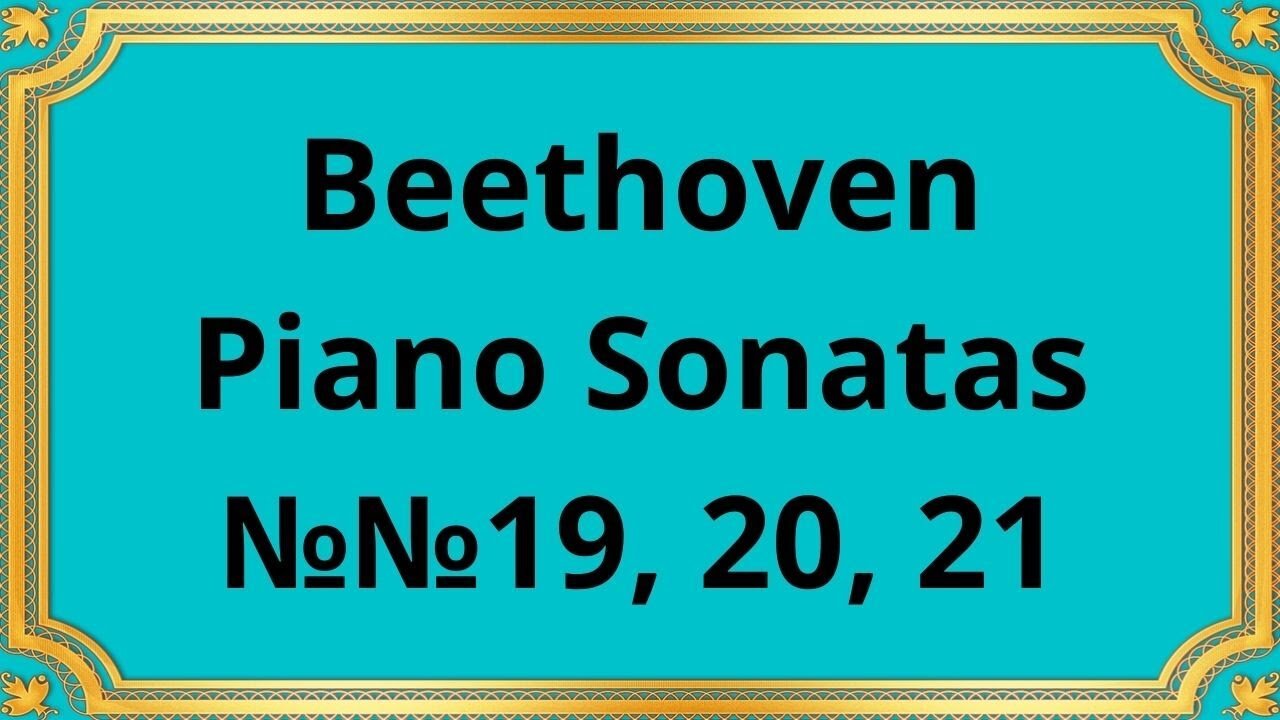Premium Only Content

Beethoven Piano Sonatas №№19, 20, 21
#Beethoven #PianoSonatas #Op49 #Op53 #ClassicalMusic #LudwigVanBeethoven #PianoCompositions #WaldsteinSonata #MusicalMasterpieces
- Sonata for piano no. 19 in G minor op. 49/1
- Sonata for piano no. 20 in sun magg. on 49/2
- Sonata for piano no. 21 in there magg. on 53 "Waldstein"
Erik Then-Bergh piano
Ludwig van Beethoven's piano sonatas stand as pillars of the classical piano repertoire, showcasing his profound musical innovation and emotional depth. The three piano sonatas, Sonata No. 19 in G minor, Op. 49/1, Sonata No. 20 in G major, Op. 49/2, and Sonata No. 21 in C major, Op. 53 "Waldstein," collectively represent a significant period in Beethoven's compositional journey, each sonata offering a unique musical narrative.
Sonata No. 19 in G minor, Op. 49/1, is a two-movement work that exemplifies Beethoven's ability to convey depth and emotion within a concise musical form. The opening movement introduces listeners to a melodic and introspective theme, with Beethoven's signature expressive phrasing and harmonic richness. The second movement, marked by its lively and spirited character, provides a delightful contrast to the introspective nature of the first movement, showcasing Beethoven's versatility in capturing a range of emotions within a compact musical structure.
Moving to Sonata No. 20 in G major, Op. 49/2, Beethoven presents a work of contrasting moods and textures. The first movement unfolds with grace and elegance, featuring lyrical melodies and intricate interplay between the hands, while the second movement, characterized by its playful and spirited nature, captivates the listener with its lively energy and joyful expression.
The Sonata No. 21 in C major, Op. 53 "Waldstein" stands as a towering achievement in Beethoven's piano sonatas, representing a significant departure from the traditional sonata form. The "Waldstein" Sonata showcases Beethoven's daring innovation and boundless creativity, with its expansive structure and technical demands. The first movement introduces the listener to a grand and majestic theme, filled with sweeping arpeggios and bold harmonic progressions, while the second movement offers a serene and introspective contrast, leading into a triumphant and exhilarating final movement that demonstrates Beethoven's mastery of musical architecture and emotional intensity.
Collectively, these three piano sonatas embody Beethoven's artistic evolution, showcasing his ability to push the boundaries of musical expression while retaining a deep connection to emotional resonance and human experience.
In conclusion, Beethoven's Sonata No. 19 in G minor, Op. 49/1, Sonata No. 20 in G major, Op. 49/2, and Sonata No. 21 in C major, Op. 53 "Waldstein" collectively represent a rich tapestry of musical expression, encapsulating Beethoven's artistic vision and enduring legacy. These sonatas continue to captivate audiences with their emotional depth, innovative spirit, and timeless relevance within the classical piano repertoire.
You have the opportunity to support the channel:
https://destream.net/live/RadSiarAl/donate
https://www.buymeacoffee.com/6355radsiaral
-
 34:26
34:26
Classical music_Music Inspiration
3 months agoAram Khachaturian Concerto for Violin and Orchestra
1442 -
 3:40:59
3:40:59
FreshandFit
11 hours agoAfter Hours w/ Girls
148K69 -
 LIVE
LIVE
Anvilight
3 hours agoFortnite | Saturday Morning Solos! | Creator Program Day #26
497 watching -
 2:06:07
2:06:07
TimcastIRL
13 hours agoDemocrats LOSE IT Over SECOND Liberal Judge ARRESTED By Trump Admin | Timcast IRL
236K225 -
 1:26:16
1:26:16
Man in America
1 day agoEXPOSED: Trump's COVERT War Against the European Banking Cartel w/ Tom Luongo
124K54 -
 1:45:48
1:45:48
Glenn Greenwald
16 hours agoGlenn Reacts to News of the Week; Plus: Audience Q&A | SYSTEM UPDATE #443
130K88 -
 11:05:38
11:05:38
Dr Disrespect
21 hours ago🔴LIVE - DR DISRESPECT - PUBG - 5 CHICKEN DINNERS CHALLENGE
255K24 -
 3:23:12
3:23:12
I_Came_With_Fire_Podcast
20 hours agoSHALL NOT BE INFRINGED| THE TYRANNY OF UNELECTED BUREAUCRATS | XI BOWS
70.8K9 -
 4:19:36
4:19:36
SynthTrax & DJ Cheezus Livestreams
22 hours agoFriday Night Synthwave 80s 90s Electronica and more DJ MIX Livestream THE GREAT EDO WARS OF 2067 Edition
106K10 -
 4:45:15
4:45:15
RalliedLIVE
13 hours ago $2.12 earnedWarzone Domination w/ Ral
77K1